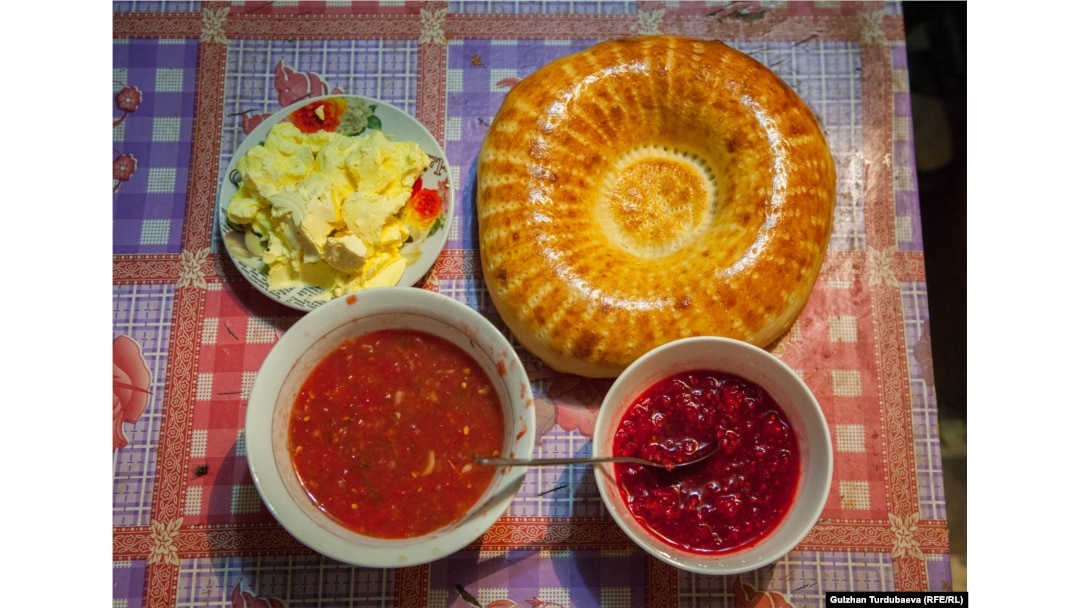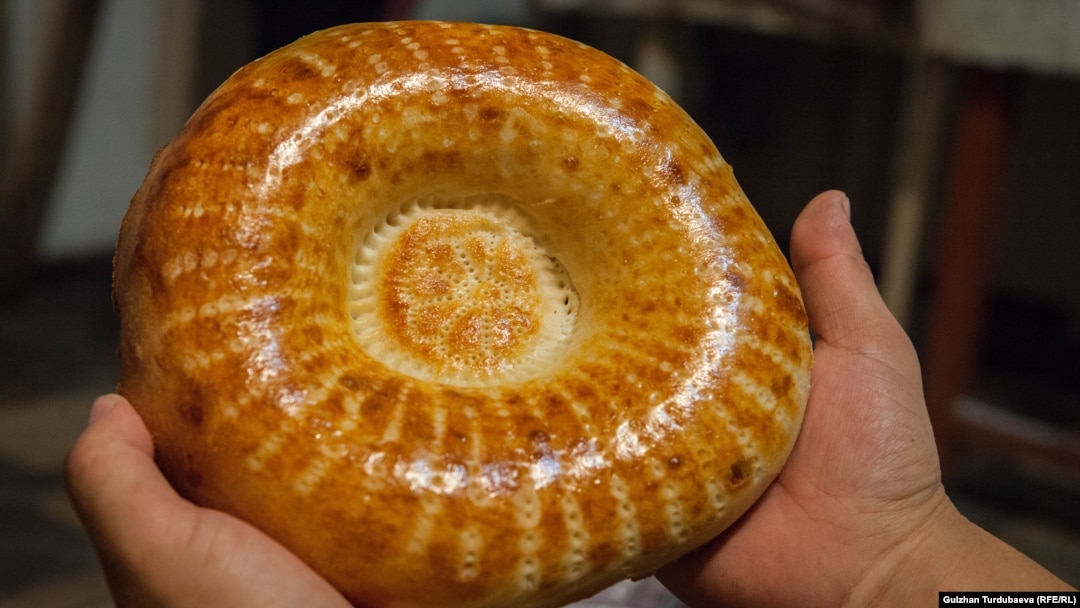BISHKEK -- People in Kyrgyzstan enjoy their daily bread with a reverence seldom seen elsewhere.
Not only is this traditional staple a core feature of the Kyrgyz diet, it's also a central facet of their culture.
Bread is broken at practically every meal and it's always offered to guests, even if they're just popping in for a minute. In fact, bread is held in such high esteem in Kyrgyzstan that it's a serious social faux pas to be seen wasting it or throwing it out unnecessarily.
Given their love of bread, it's not surprising that the Kyrgyz have come up with lots of interesting variations on the theme, ranging from borsok -- bite-sized, golden nuggets of deep-fried dough that are eaten on every special occasion -- to kattama -- a flaky fried pastry that is famous for its buttery taste.
But pride of place belongs to the tandyr nan -- a decorative disk-shaped flatbread adorned with simple patterns. It's baked in a traditional tandoor, a clay oven that has been used in this part of the world for centuries.
Popularly known as lepyoshka or tokach, this moist fluffy bread with a crispy crust is well-known as a Central Asian bread, and it's long been standard fare in every Kyrgyz household. Often taken with tea, it is usually eaten with a variety of condiments, including various jams and compotes, kaymak (a kind of clotted cream), and butter.

Considering its pivotal place in Kyrgyz society, bakeries that make lepyoshka have been part of the local way of life for generations.
Traditionally, lepyoshka bakeries in Kyrgyzstan were a family business passed from father to son. But such is the insatiable appetite for this traditional flatbread that hundreds of new establishments have been opening in the Kyrgyz capital in recent years to cater to the demand.
Esenbek Nabiev, who returned home to Kyrgyzstan after several years working as a migrant in Russia, has found employment at one Bishkek bakery.
Esenbek Nabiev
While the rest of the city sleeps, Nabiev and three other bakers work through the night to make around 2,000 of these loaves, which are fresh and ready to eat each morning.
The working day begins at 2 a.m. when some 150 kilograms of high-quality wheat flour is delivered to the bakery from a warehouse.
Work begins straight away as the bakers sift the flour to make the dough.
Many varieties of this bread are made, but the basic mixture consists of flour, butter, salt, water, and yeast.
Once the dough has been properly kneaded, it's divided into portions.
Then, each loaf is shaped until it is round with a flattened center.
The loaves are then decorated with patterns using a traditional stamping tool known as a chekkich, which is dipped in oily water.
The molded dough is glazed with a mixture of egg yolk and milk to ensure the finished bread has a shiny crust.
During this time, the bakery's two tandyr ovens, which are used to cook the bread, are heated with a wood fire.
The bread is baked using the heat of the oven walls. After being fired up for a few hours, water is usually splashed on the inner sides of the tandyr. Its rate of evaporation is used to check that the temperature is just right for making the perfect nan.
The tandyr is a localized version of the tandoor, a cylindrical, wood-fired oven believed to have originated in Persia some 5,000 years ago.
It's an ingenious, convection-cooking device whose greatest advantage is that its clay walls, once heated properly, remain consistently hot for hours, making it ideal for cooking in parts of the world where fuel is often scarce.
Traditional Kyrgyz tandyr ovens are molded from moistened clay strengthened with strands of sheep's wool. They are usually shaped by hand and then left to dry in the sun. A typical tandyr oven can be used for 20 years.
Sheep's Wool And Clay: Making Traditional Kyrgyz Tandyr Ovens
Each loaf in the bakery where Nabiev works is allowed time to rise a little before being transferred to the tandyr.
The finished dough is kept in a room next to the oven. The loaves are passed through a hatch to ensure that they stay as warm as possible without spoiling their special shape and fluffy consistency.
Once the dough is ready, the sticky loaves are placed on the sides of the tandyr. Smoke from the smoldering wood helps give the bread its unique flavor.
Besides its decorative effect, the flattened centers of the loaves also help to ensure that the bread is baked quickly. Each batch only takes about six to nine minutes to make.
After being scooped out, they are left to cool before being ready for market.
There are at least 20 common variations of tandyr nan in Kyrgyzstan, ensuring that this ubiquitous staple always offers plenty of variety for even the most discerning taste buds.
Nabiev's bakery makes four standard versions, including plain lepyoshka, extra buttery tandyr nan, and flatbread flavored with onions.
The bakery opens for business at 7 a.m. and work is usually done for the day by noon.
Although business is brisk, the bakery also makes enough bread to supply many street vendors, whose stalls are a common sight on practically every street in the Kyrgyz capital.


